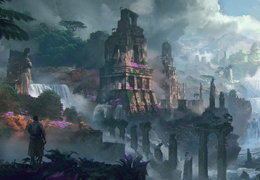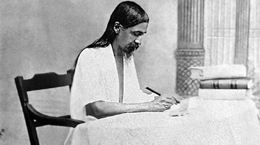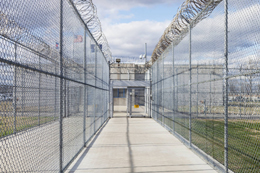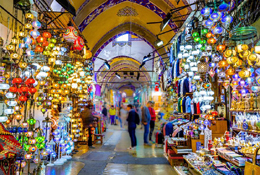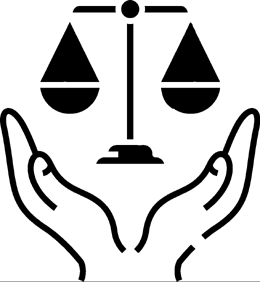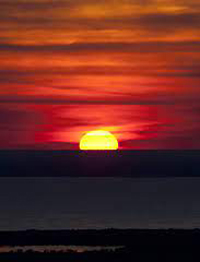Consciousness and health
On Fantasy and Reality
Abstract
This piece is a short reflection on taking the mystic core of religion seriously. With rational empiricism on one side and conventional modes of worship on the other, the claim of mysticism is often reduced to imagination or fantasy, or dismissed as a biologically constructed experience. It is rather a real and concrete, yet non-material, expression of our inmost being, in both its individual and collective manifestations, and one that we must work to discover for the new creation to be born tomorrow out of today’s tumult.
Here’s a thought: perhaps the world we live in is a fantasy. And what we call a fantasy is truly real. Our disenchanted, buffered self, purely rational, proud of its empiricism, unbelieving in anything other than what we perceive through the senses, or what our minds can process, is a fantasy — an incarceration of our limited imagination. What we call fantastical, out of our ordinary reach, of another world, another dimension, is perhaps what is ultimately more real —what the sage sees, not only thinks, praśyanti buddhiḥ, once our permanent cataracts have been surgically removed by a ray from the Sun of Knowledge, tatsavitur.
There are worlds beyond, beings beyond, states beyond our current reach, hidden deep within our limited, moral frames — a world quite unlike ours, fantastical only because we have consented to this long imprisonment of our material mind. But it’s not a creation of the imagination, an escape from reality into a better world created out of our minds, a relief for the novelist, a weekend getaway from our work-a-day reality, a “revel of intellect and fancy, imagination, a plaything and caterer for our amusement, our entertainer, the nautch-girl of the mind (1).” Quite the opposite — this, all this around us, the real, after all, the great traditions tell us, is not so — it is a cover, a dream, a mayā from which we wake up into a world of the real, the wonderful, where the laws of physics dance with the greater laws of beauty and harmony, of wonder and delight.
Visions from elsewhere come, in those gleaming moments of silence, when we forget ourselves and see beyond. Yet, long habit, and a scientism that has cancelled the capacity to feel our depths without a calculator in hand, insists that it is only a quirk of momentary biochemical imbalance, an oddity of the neural network, to be explained away into some mathematical inconsequence. Our intellect, towering in its victory over the world, master of industry and science, has left the poet, the seer in us dry — an objectivism that denies the soul, and insists on its deadening, universal law. As the great poet said:
“Imposed its rigid artifice on the soul;
An aide of the inventor intellect,
It cut Truth into manageable bits
That each might have his ration of thought-food,
Then new-built Truth’s slain body by its art:
A robot exact and serviceable and false
Displaced the spirit’s finer view of thing (2).”
But another view is possible, a magical realism that carries our buried hopes for a greater world, a reality, what seems to us fantasy, that is lurking behind, looking to invade us if we permit ourselves to travel to other worlds. The inert body of God, plumbed by our science, waiting for a “glow of the Unmanifest (3)”, an experience of something unearthly, yet so real that a single glance can change our lives forever. “A glory and a rapture and a charm (4)” in a world of matter — where the only eternal law is not of gravity, nor of Darwin, but of pain, suffering and decay — sits “unknown within the heart (5)”, waiting for the adventurer soul — which is fantasy, which is real? So asked King Janaka, caught between two worlds, unsure if he was asleep or awake.
Our world is an illusion, a tragic dream and something in us looks to break free. There is no reason, no why, only a wonder, a longing, a seeking that is beyond words. And nothing can convince us otherwise, no grim earthliness can deny us our unearthly longings, for a greater reality: for that rare magic gleam seems more real than a lifetime of earthly labour. A vision, a light, a momentary glimpse of another world — the supreme dissent of our soul, trapped in this little bodily frame:
“The mystic tract beyond our waking thoughts,
A door parted, built in by Matter’s force,
Releasing things unseized by earthly sense:
A world unseen, unknown by outward mind
Appeared in the silent spaces of the soul.
He sat in secret chambers looking out
Into the luminous countries of the unborn
Where all things dreamed by the mind are seen and true
And all that the life longs for is drawn close (6).”
Yet proud are we, “unbelieving sons and daughters of modernity (7)”, of our enlightened material incarceration. The living fire within, the Fire that upholds the worlds, the immaterial cause of our material existence, made immaterial — “inflicting on the heights the abysm’s law, it sullies with its mire heaven’s messengers (8).” Matter explored, the atom blasted open, the last of the virgin lands mapped and a developmentalism that has conquered the Earth. A statistical environmentalism and an economy that has consumed our souls, along with our forests. A world without magic.
So, where do we go? Where in this reality do we find our fantasy? “The age of adventures is over (9)”, said the great adventurer. We are prisoners of our progress, crushed under the weight of our so-called civilisation. Yet perhaps this tragedy, this eternal damnation of our souls to a search for wonder that constantly closes in around us, strangling our hearts, is itself a fantasy, an unreality. For God could not be so cruel. Or so unimaginative. Perhaps he created much more than our eyes can see.
As one who loved truly said:
“Hypnotized as we are by the “inescapable” scientific conditions of the present world, we have come to believe that our hope lies in an ever greater proliferation of machines, which will see better than we do, hear better than we do, calculate better than we do, heal better than we do — and finally, perhaps, live better than we do. Indeed, we must first realize that we can do better than our machines, and that the enormous Mechanism that is suffocating us is liable to collapse as quickly as it came into being, provided we are willing to seize on the true power and go down into our own hearts, as methodical, rigorous, and clearheaded explorers (10).”
And what will we find there? That is for each to see, to feel, to explore by the light of his own being. But perhaps the journey is worth it. And we may, if we are lucky, find that we are more than we think, for our inner worlds are as real as they are fantastical, as unknown as they are dark and wonderful. There are gods and demons, fairies and wild beasts, hounds of darkness and sons of light — worlds of infernal horror and empyrean heights and all else in between beyond the ebony gates of our dim earthly existence, where the lines between reality and fantasy blur, if they ever existed at all:
“… imagination’s comet trail of dream,
Took now a close shape of reality.
The gulf between dream-truth, earth-fact was crossed,
The wonder-worlds of life were dreams no more (11).”
We are no longer buyers in “utility’s immense bazaar”, enamoured of “logic’s infallible ... chain (12)”, purveyors of an objective reality. We want not mythical images or glorious performances, as desperate attempts neither to recover our lost wonder, nor to delude ourselves with subjective fantasies, which are really nothing but momentary escapes from the decorated impotence of our lives. We don’t believe, nor do we disbelieve: we want to see, to feel. We are seekers of another world, of “the Real towards which our strivings move, the secret grandiose meaning of our lives (13).”
There is a collective dimension too — the social life-world is a developing group-soul, that sets each in relation to the other in this exploration of liberating subjectivities. Our collective lives are not just a mass of individual biographies, with private fantasies pitted against a public reality, but tied together by a thread of common adventure into inner worlds, where we gather and talk, just as we do here. Our “earthly dialect” must to “God-language change (14)”, a “satisfying evolution of the nascent spirituality still raw and inchoate in the race is the possibility to which an age of subjectivism is a first glimmer of awakening (15).” The social can free us, our contact with others can nourish and enliven us, open new possibilities for a collective fulfilment. Yet, a formidable challenge lies:
“An absolute State found order’s absolute,
To a standardised perfection cut all things,
In society build a just exact machine.
Then science and reason careless of the soul
Could iron out a tranquil uniform world,
Aeonic seekings glut with outward truths
And a single-patterned thinking force on mind,
Inflicting Matter’s logic on Spirit’s dreams
A reasonable animal make of man
And a symmetrical fabric of his life (16).”
The secret possibility of living out our greater fantasies, as expressions of the Real, is “a new kind of theocracy, the kingdom of God upon earth, a theocracy which shall be the government of mankind by the Divine in the hearts and minds of men (17).” This society, a leap of collective imagination, built on a world-making fantasy “can alone bring about a reign of individual harmony and communal happiness (18).” The inner change, the recovery of our lost, or forgotten, glory, will be an anthem of light, taking us — with those masters of men who came down in the Axial Age — out of the “stammer of the primal ignorance” into a world of “vision and dream”, fantasies yet still, yet truly “fables spoken by the truth” in “symbols more veridical than fact (19).”
Man must believe in himself, and in his fellow-souls — our polity needs an “alternative telos of becoming, a will to universality and oneness through deep relationality and intense intimacy (20)”, bound by the mortar of our collective fantasies. They are tomorrow’s realities, and for that we must take them seriously — for our communal life to regain its splendour and heaven-ward charm, to infuse with a radiant power earth’s dumb need for transcendence in something beyond.
Our reality is a pale reflection of all that is hidden in us — “the idealistic easily seems to us something unreal, fantastic, unsubstantial, nebulous, a thing more of thoughts and words than of live actualities, because it is trying to embody a reality not yet accomplished (21).” Yet, our fantasies are truly “messengers from our subliminal greatnesses, guests from the cavern of the secret soul (22),” till we awake and imprint this world with another, one much sweeter, stronger. “In that life more concrete than the lives of men, throbbed heart-beats of the hidden reality” — may “jingling sweet anklet-bells of fantasy” sound again, “where life and being are a sacrament offered to the Reality beyond (23).”
References
1. Sri Aurobindo, The Complete Works of Sri Aurobindo, Volume 25. Pondicherry: Sri Aurobindo Ashram Trust; 1997, p. 9.
2. Sri Aurobindo, CWSA, Volume 33; 1997, p. 242.
3. Ibid., p. 42.
4. Ibid., p. 43.
5. Ibid.
6. Ibid., p. 27.
7. Habermas J. Post Metaphysical Thinking II: Essays and Replies. Cambridge: Polity Press (transl. by Cronin C); 2017, p. 56.
8. Sri Aurobindo. CWSA, Volume 33, p. 7.
9. Satprem, Sri Aurobindo or the Adventure of Consciousness. Paris: Institut de Recherches Évolutives; 2008, p. 11.
10. Ibid., p. 12.
11. Sri Aurobindo. CWSA, Volume 33, p. 120.
12. Ibid., p. 252.
13. Ibid., p. 49.14. Ibid., p. 76.
15. Sri Aurobindo. CWSA, Volume 25, p. 182.
16. Sri Aurobindo. CWSA, Volume 33, p. 255.
17. Sri Aurobindo. CWSA, Volume 25, p. 183.
18. Ibid.
19. Sri Aurobindo. CWSA, Volume 33, p. 30.
20. Banerji D. Becoming-Earth, Becoming-World: Posthuman Identity in the Polis of Divine Anarchy [Online] Available from: https://posthumanism.in/articles/becoming-earth-becoming-world-posthuman-identity-in-the-polis-of-divine-anarchy-by-debashish-banerji/ [Accessed 11th January, 2022].
21. Sri Aurobindo. CWSA, Volume 25, p. 242.
22. Sri Aurobindo, CWSA, Volume 34, p. 500.
23. Sri Aurobindo, CWSA, Volume 33, p. 190.
Raag Yadava is Assistant Professor of Law at the National Law School of India University, Bangalore.
Share with us (Comments,contributions,opinions)
When reproducing this feature, please credit NAMAH,and give the byline. Please send us cuttings.

